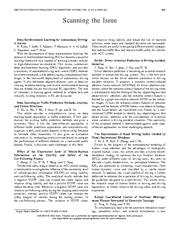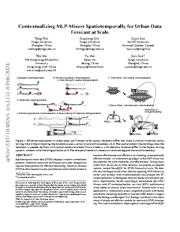A copy of this work was available on the public web and has been preserved in the Wayback Machine. The capture dates from 2022; you can also visit the original URL.
The file type is application/pdf.
Filters
Scanning the Issue
2022
IEEE transactions on intelligent transportation systems (Print)
A novel traffic prediction model is proposed based on Graph Attention Network and the graph of the road network is constructed at the turn level. ...
Then, a CNN-LSTM hybrid neural network model is developed to forecast the real-time speed using one-feature prediction and multi-feature prediction. ...
Luan This article establishes an intelligent multi-attribute service response framework in a smart city based on the request of users and the response of AVs. ...
doi:10.1109/tits.2022.3174254
fatcat:o6z3ncdkgbh5dmvvywtok7hwke
Deep Occupancy-Predictive Representations for Autonomous Driving
[article]
2023
arXiv
pre-print
By leveraging a map-aware graph formulation of the environment, our agent-centric encoder generalizes to arbitrary road networks and traffic situations. ...
Manually specifying features that capture the diversity in traffic environments is impractical. ...
By adopting graph neural networks (GNNs) as RL policies, recent works have outperformed traditional approaches relying on fixed-sized feature vectors. ...
arXiv:2303.04218v1
fatcat:vnnidm7zofccbdxfj6hh3ftfne
Contextualizing MLP-Mixers Spatiotemporally for Urban Data Forecast at Scale
[article]
2024
arXiv
pre-print
Experimental results surprisingly demonstrate that MLP-Mixers with ST-contextualization can rival SOTA performance when tested on several urban benchmarks. ...
Furthermore, it was deployed in a collaborative urban congestion project with Baidu, specifically evaluating its ability to forecast traffic states in megacities like Beijing and Shanghai. ...
These models used the three largescale urban datasets to forecast the traffic speed across the entire network. ...
arXiv:2307.01482v5
fatcat:5hm3xydfrfb4ljv36aij5iwrym
Deep Learning for LiDAR Point Clouds in Autonomous Driving: A Review
[article]
2020
arXiv
pre-print
Although several published research papers focus on specific topics in computer vision for autonomous vehicles, to date, no general survey on deep learning applied in LiDAR point clouds for autonomous ...
Recently, the advancement of deep learning in discriminative feature learning from 3D LiDAR data has led to rapid development in the field of autonomous driving. ...
Graph Attention Networks (GAT) [75] . ...
arXiv:2005.09830v1
fatcat:zrja5sgtsvgulpnp7p7t4kxq54
Peer-to-Peer Shared Ride Systems
[chapter]
2008
Lecture Notes in Computer Science
A peer-to-peer shared ride system allows clients to find rides in an ad-hoc manner, by negotiating directly with nearby hosts via radio-based communication. ...
on traffic. ...
These common features and behavior are identified and encapsulated in the base class agent. ...
doi:10.1007/978-3-540-79996-2_14
fatcat:qmrec6lxbbeddfzy7rcax3blee
An Improved Multimodal Trajectory Prediction Method Based on Deep Inverse Reinforcement Learning
2022
Electronics
In order to further enhance prediction accuracy by making full utilization of complex traffic scenes, an improved multimodal trajectory prediction method based on deep inverse reinforcement learning is ...
Firstly, a fused dilated convolution module for better extracting raster features is introduced into the existing multimodal trajectory prediction network backbone. ...
Trajectory Generation Based on Attention Mechanism The structure of the trajectory generator based on an attention mechanism is a soft attention-guided recurrent neural network encoder-decoder [35] . ...
doi:10.3390/electronics11244097
fatcat:zh7x6a5uovf7fe4aj276x6oazu
StarNet: Joint Action-Space Prediction with Star Graphs and Implicit Global Frame Self-Attention
[article]
2022
arXiv
pre-print
In this work, we present a novel multi-modal multi-agent trajectory prediction architecture, focusing on map and interaction modeling using graph representation. ...
We achieve this via masked self-attention. ...
Hence, virtually all recent state-of-the-art approaches use graph-based learned models such as GNNs and Multi-Head Attention (MHA), which is related to the Transformer architecture 2 [6] . ...
arXiv:2111.13566v2
fatcat:teena5lgwnfnpmqruitav5bfs4
Research on the Deep Recognition of Urban Road Vehicle Flow Based on Deep Learning
2020
Sustainability
the feature vectors of all vehicles in the traffic flow and to intelligently determine the real-time statistics of vehicle flow based on the change of distance between vectors. ...
Learning from the characteristic that the cosine distance between the feature vectors of the same target in different states is in a fixed range, we designed a deep feature network model (D-CNN) to extract ...
On urban roads, traffic jams, an unreasonable control of traffic lights, and many other traffic phenomena often occur. ...
doi:10.3390/su12177094
fatcat:qqwxxnnm2ngntcys3ziw3sth6m
Autonomous Driving with Deep Learning: A Survey of State-of-Art Technologies
[article]
2020
arXiv
pre-print
Due to the limited space, we focus the analysis on several key areas, i.e. 2D and 3D object detection in perception, depth estimation from cameras, multiple sensor fusion on the data, feature and task ...
Since DARPA Grand Challenges (rural) in 2004/05 and Urban Challenges in 2007, autonomous driving has been the most active field of AI applications. ...
and traffic network, 3-D virtual environment (urban and rural scenes) and driving behaviour modelling (age, culture, race etc.) ...
arXiv:2006.06091v3
fatcat:nhdgivmtrzcarp463xzqvnxlwq
A Spatial–Temporal Causal Convolution Network Framework for Accurate and Fine-Grained PM2.5 Concentration Prediction
2022
Entropy
Time-dependent features in causal convolution networks are extracted by stacked dilated convolution and time attention. All the hyper-parameters in ST-CCN-PM2.5 are tuned by Bayesian optimization. ...
Both the spatial effects of multi-source air pollutants and meteorological factors are considered via spatial attention mechanism. ...
convolution network is proposed to improve the performance of sequence-based models and graph-based ones. ...
doi:10.3390/e24081125
pmid:36010788
pmcid:PMC9407057
fatcat:fir2dxte3rchzljr6rqmhqul6q
Artificial Intelligence for Complex Network: Potential, Methodology and Application
[article]
2024
arXiv
pre-print
Through this comprehensive survey-the first of its kind on AI for complex networks-we expect to provide valuable insights that will drive further research and advancement in this interdisciplinary field ...
Over the past two decades, complex network science has significantly enhanced our understanding of the statistical mechanics, structures, and dynamics underlying real-world networks. ...
The widely-used model architecture is the combination of recurrent neural network (RNN) and self-attention mechanism (SAM), while a recent work [36] finds that a simple architecture based on multi-layer ...
arXiv:2402.16887v1
fatcat:em3mdauptjd47ejmsv5pe4v5rm
TrajGen: Generating Realistic and Diverse Trajectories with Reactive and Feasible Agent Behaviors for Autonomous Driving
[article]
2022
arXiv
pre-print
In particular, TrajGen consists of the multi-modal trajectory prediction stage and the reinforcement learning based trajectory modification stage. ...
In the first stage, we propose a novel auxiliary RouteLoss for the trajectory prediction model to generate multi-modal diverse trajectories in the drivable area. ...
efficient vectorized representation with graph attention networks for multi-modal prediction. ...
arXiv:2203.16792v1
fatcat:p75sxbq5trajne2bkbuixqczgu
Exploring Map-based Features for Efficient Attention-based Vehicle Motion Prediction
[article]
2022
arXiv
pre-print
In this work, we explore how to achieve competitive performance on the Argoverse 1.0 Benchmark using efficient attention-based models, which take as input the past trajectories and map-based features from ...
These features represent interpretable information as the driveable area and plausible goal points, in opposition to black-box CNN-based methods for map processing. ...
Other approaches based on Graph Neural Networks (GNNs) such as GOHOME [17] and LaneGCN [34] have achieved SOTA results on the most relevant benchmarks for Motion Prediction [7, 17, 34] . ...
arXiv:2205.13071v2
fatcat:cxrmcjo7rrejhd63mkejgxjxme
Contents
2021
2021 IEEE 10th Data Driven Control and Learning Systems Conference (DDCLS)
Shuo Xu, Le Luan, Zhong Xu, Kai Zhou, Qianwen Guo, Yao Xiao, Yu Wang 328 Short-term Traffic Flow Prediction Based on Ensemble Machine Learning Strategies ……………………………………………………..... ...
Graph Convolutional Networks ……………………...Wenkang Huang, Huanlei Guo, Jie Wang, Junqing Yuan, Xiongxiong He, Jiajun Ding 796 Similar-Density-Array-Based Equipment Outage Prediction Method for Distribution ...
doi:10.1109/ddcls52934.2021.9455485
fatcat:7n7tpgqsuvg55og6dwwuj6g2xe
Capturing Omni-Range Context for Omnidirectional Segmentation
[article]
2021
arXiv
pre-print
In addition to the learned attention-based contextual priors that can stretch across 360-degree images, we upgrade model training by leveraging multi-source and omni-supervised learning, taking advantage ...
Our novel model, training regimen and multi-source prediction fusion elevate the performance (mIoU) to new state-of-the-art results on the public PASS (60.2%) and the fresh WildPASS (69.0%) benchmarks. ...
This trend prompts a variety of attention modules [6, 24, 30, 32] , as well as graph-based models [77, 89] and factorized variants [23, 51, 75] . ...
arXiv:2103.05687v1
fatcat:n3ej2ujenbhcnc7mtoufufcwai
« Previous
Showing results 1 — 15 out of 747 results














